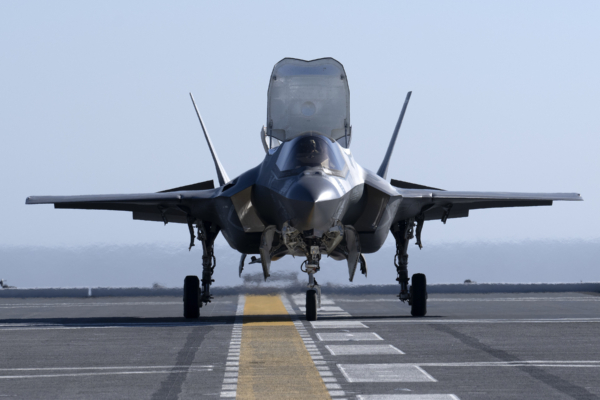On Monday, October 21st, the US Navy Pacific Fleet announced that a US F-35 stealth fighter jet had landed for the first time near the California coast on the newly converted Japanese destroyer, the JS Kaga, now serving as a new aircraft carrier. They also shared photos of the fighter jet landing.
The test operation, conducted on Sunday, October 20th, marks an important step in integrating US Marine Corps and UK Navy carrier-based, short take-off and vertical landing F-35B jets into the Japanese Maritime Self-Defense Force’s new aircraft carrier.
The JS Kaga arrived in San Diego in September, working with the US military to integrate F-35 aircraft onto this newly modified carrier. The JS Kaga, previously a helicopter carrier, has undergone carrier modifications completed in April, enabling it to launch and recover F-35B jets.
The carrier modifications include a deck coated with heat-resistant materials to withstand the F-35B’s thrust vectoring engine, redesigned flight deck lighting for night operations, and reshaping the flight deck bow from a trapezoid to a rectangle.
On Monday, the Pacific Fleet issued a statement saying a test pilot successfully landed an F-35B fighter jet equipped with special equipment on the JS Kaga around 3:15 pm on Sunday.
“This test is crucial for strengthening Japan’s defense capabilities. We will make every effort to achieve good test results in collaboration with the Pax ITF.” Commander of the Japanese Maritime Self-Defense Force’s JS Kaga, Shusaku Takeuchi, said, “This trial not only enhances the maritime self-defense force’s capabilities but also improves interoperability between Japan and the United States, enhancing the deterrence and response capability of the Japan-US alliance, thus contributing to peace and stability in the Indo-Pacific region.”
In addition to the F-35B test pilot, the US Pax ITF team includes aircraft maintenance personnel, flight test engineers, flight test control engineers, flight deck personnel, and logistics support, backed by the US Navy and Marine Corps.
“We are proud to be part of this joint effort to test the compatibility of the F-35B on the JS Kaga.” Seth Dion, head of the Pax ITF team, said, “Our team has prepared meticulously for this mission, and we are committed to close cooperation with allies to achieve our common goals and enhance our partnership.”
The JS Kaga is conducting sea trials in waters near California, expected to take about three weeks to accommodate F-35B jets. The successful conversion of the JS Kaga also paves the way for another Japanese helicopter carrier, the Izumo, to be modified into an aircraft carrier.
Once the JS Kaga and the Izumo receive full certification for successful jet operations, Japan will have naval capabilities not seen since World War II.
The US and Japan are increasingly engaging in close military cooperation, working together to counter hostile actions by China in the East China Sea and South China Sea. For Japan, having the capability to deploy its own or US F-35B jets on converted light aircraft carriers under the tense conditions in the Indo-Pacific region, especially amidst China’s aggressive posture, could be very effective in deterring potential threats from China.
Japanese light aircraft carriers will be another significant challenge for China, with the advantages of F-35B jets enhancing Japan’s naval strength. Along with reinforced military cooperation among Japan, the United States, and other countries, these developments are unsettling for China.
In December 2022, then Commander of the US Seventh Fleet, Vice Admiral Karl Thomas, stated that US light “Lightning Carriers” had significantly superior capabilities compared to China’s active aircraft carriers.
Apart from being short takeoff and vertical landing (STOVL) jets, the F-35B’s advanced sensor array allows it to serve as a battlefield hub, transmitting information to allied forces across a wide area, giving it an edge over China’s primary carrier-based aircraft, the J-15.
“There is no comparison between the J-15 and F-35B.” Thomas explained.

